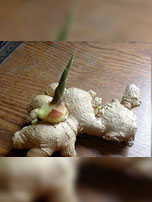SHAHEED KARTAR SINGH SARABHA AYURVEDIC MEDICAL COLLEGE & HOSPITAL
Affiliated to Guru Ravidas Ayurved University, Hoshiarpur Punjab
Affiliated to Guru Ravidas Ayurved University, Hoshiarpur Punjab

Botanical Name: Zingiber officinale Rosc.
Family: Zingiberaceae
Introduction: Mainly dried ginger using in Ayurveda formulation.. So it used as the prashepa dravyas for many drugs.
Names in different Indian languages:
English : Ginger
Hindi : Adarak
Kannada : Hasisunti, Ardraka
Malayalam : Inci, Erukkilannu
Sanskrit : Ardrakam
Tamil : Inji, Allam, Lokottai
Telugu : Allamu,ardrakamu
Unani : Zanjabeele- Ratab,Al-Zanjabeel
Dry Rhizome
English : Dry Ginger
Hindi : Soth
Kannada: sunti
Malayalam: Chukku
Sanskrit : Sunthi, Visvabhesajam
Tamil : Chukku, Sunthi
Telugu : Sunti
Unani : zanjabeel,Zanjabeel-eyaabis.
Synonyms :
Fresh rhizome—
Aardraka, Aadrikaa, Shrngibera, shrngavera, Katubhadra.
Dried rhizome—
Shunthi, Naagara,Naagaraa, Naagaraka, Aushadha, Mahaushadha, Vishvaa, Vishvabheshaja, Vishvaaushadha
Amomum zingiber L.
Classification according to Charaka, Susrutha & Vagbhata :
Charaka : Triptighna, Arsoghna, Dipaniya, sulaprasamana, Trisnã nigrahana
Susrutha : Pippalyãdi, Trikatu
Vagbhata : Pippalyãdi, Trikatu
Varieties & adulterants – (CV – controversy, AD – adulterants) :
1. Dry Ginger – Nagara, Visvabhesaja
2. Fresh Ginger – Ardraka, Srngabera.
Morphology:
An erect perennial herb with aromatic rhizome.
Stem— erect, leafy, 15-150 cm tall.
Leaves— subsessile, linear-lanceolate or lanceolate, acuminate, glabrous, 10-30 cm long.
Flowers— shoot upto 15 cm long, clothed with sheaths; bracts -2-5 cm x 2 cm, light green; corolla tube light yellow, lip orbicular, dull purple with creamy blotches.
Flowering and fruiting during July-September
Habitat & Distribution :
All over India, Srilanka, Nepal
Chemical composition :
geranial and neral; and sesquiterpenes, beta-sesquiphellandrene, betabisabolene,
ar-curcumene and alphazingiberene, gingerols, shogaols, curcumene, beta-boürbornene, d-borneal, citral, d-camphene, citronellol, geraniol, gingerol, a- & beta- Zingiberenes, zingiberol, zingerone, gingerols, paradol, gingerenone A, ginger glycolipids A, B, & C; gingerdiol; gingerone B & C
Properties :
Rasa : Katu
Guna : Guru Ruksa, Tiksna
Virya : Usna
Vipãka : Madhura
Karma : Vãta-kaphahara, Dipana, Bhedana,pachana, vrisya, balya, rochana, sophahara, jwaraghna
antiemetic, antiflatulent, hypocholesterolaemic, anti-inflammatory, antispasmodic, expectorant, laxative,circulatory stimulant, diaphoretic, anti-inflammatory, antipyretic, analgesic, hypotensive and hepatoprotective.
Gingerol and shogaol have been shown to suppress gastric contractions. Both fresh and dried rhizomes suppress gastric secretion and reduce vomiting
Indications :
Sula, Amavãta, Adhmãna, Atisãra, slipada, Kãsa, svãsa, Hrdroga, sopha, Arsas, Hikkã, Vibandha, Raktapitta, Pãndu, Vrana, Jvara. Kustha, Agnimãndya
Irritable bowel , diarrhoea, fever,cough, asthma,flatulence,colic, colds ,influenza,migraine, nausea, vomiting
Part used :
Rhizome (raw and dry)
Dosage :
Powder 2-4 g
Decoction 50-100 ml
Important Yoga’s or Formulations :
Ardraka rasayana, Ardraka Khaãvalehya, Nagaradi Kasaya,Ardraka ghrta, Ardraka Khanda, Soubhaya Suñti, Samasarkarã churna
Therapeutic Uses :
(1) Pratisyaya— Ardraka is given with milk (S.S.Ut. 24).
(2) Kaphaja Arsas— Ardraka and Kulastha are used (S.S.Ci.6)
(3) Murcha— Ardraka svarasa is used as Nasya (B.P.).
